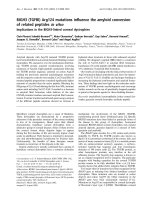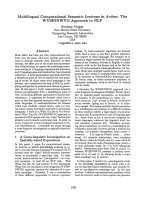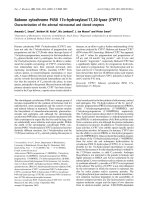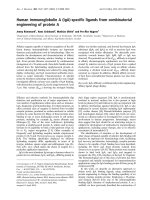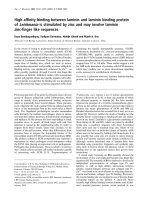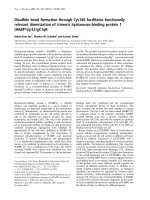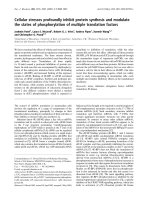Báo cáo y học: " Tidal breathing flow-volume loops in bronchiolitis in infancy: the effect of albuterol [ISRCTN47364493]" docx
Bạn đang xem bản rút gọn của tài liệu. Xem và tải ngay bản đầy đủ của tài liệu tại đây (59.51 KB, 6 trang )
Critical Care April 2001 Vol 6 No 2 Totapally et al.
Research
Tidal breathing flow-volume loops in bronchiolitis in infancy:
the effect of albuterol [ISRCTN47364493]
Balagangadhar R Totapally*, Cem Demerci
†
, George Zureikat
‡
and Brian Nolan
§
*Program Coordinator, Pediatric Critical Care Fellowship, Division of Critical Care Medicine, Miami Children’s Hospital, Florida, USA
†
Director of Ambulatory Pediatrics, Hurley Medical Center, Flint, Michigan, USA
‡
Director of PICU, Hurley Medical Center, Flint, Michigan, USA
§
Director of Pediatric Critical Care, Hurley Medical Center, Flint, Michigan, USA
Correspondence: Balagangadhar R Totapally,
Introduction
The use of inhaled bronchodilators to treat children with bron-
chiolitis remains controversial [1–4]. The controversy may be
the result of differences in study populations, in choice of
bronchodilators, or in measured outcome variables between
trials. One common confounding variable of past studies has
25/PT = the ratio of tidal expiratory flow at 25% of the remaining tidal volume to peak tidal expiratory flow; PTEF = peak tidal expiratory flow; RSV =
respiratory syncytial virus; TBFV = tidal breathing flow volume; TEF10 = tidal expiratory flow at 10% of the remaining tidal volume; TEF25 = tidal
expiratory flow at 25% of the remaining tidal volume; TEF50 = tidal expiratory flow at 50% of the remaining tidal volume; t
PTEF
/t
E
= the fraction of
exhaled time to achieve peak tidal expiratory flow to total expiratory time; V
PTEF
/V
E
= the fraction of exhaled volume to achieve peak tidal expiratory
flow to total expiratory tidal volume.
Abstract
Objectives To evaluate the effect of nebulized albuterol on tidal breathing flow-volume loops in infants
with bronchiolitis due to respiratory syncytial virus.
Design A randomized, double-blind, control study.
Setting Pediatric unit in a community teaching hospital.
Participants Twenty infants younger than 1 year of age (mean age, 5.8 ± 2.8 months) with a first
episode of wheezing due to respiratory syncytial virus bronchiolitis.
Interventions Chloral hydrate (50 mg/kg) was administered orally for sedation. One dose each of
nebulized albuterol (0.15 mg/kg in 3 ml saline) and saline (3 ml) were given at 6 hour intervals in a
random order.
Measurements Tidal breathing flow-volume loops were obtained before and after each aerosol
treatment with a Neonatal/Pediatric Pulmonary Testing System (Model 2600; Sensor Medics,
Anaheim, CA, USA). At the same time, the fraction of tidal volume exhaled at peak tidal expiratory flow
(PTEF) to total tidal volume (V
PTEF
/V
E
), and the fraction of exhaled time at PTEF to total expiratory time
(t
PTEF
/t
E
) were measured. The PTEF, the tidal expiratory flows at 10%, 25%, and 50% of the remaining
tidal volume (TEF10, TEF25, and TEF50), and the wheeze score were also determined.
Results There were no significant changes in V
PTEF
/V
E
and t
PTEF
/t
E
after albuterol or saline treatment.
PTEF increased significantly both after albuterol and saline treatments but the difference between the two
treatments was not significant (P = 0.6). Both TEF10 and the ratio of the tidal expiratory flow at 25% of
the remaining tidal volume to PTEF (25/PT) decreased significantly (P < 0.05) after administration of
albuterol. All other investigated variables were not significantly affected by aerosol administration.
Conclusions Nebulized albuterol in infants with mild bronchiolitis due to respiratory syncytial virus did not
improve V
PTEF
/V
E
and t
PTEF
/t
E
but did decrease TEF10 and 25/PT.
Keywords albuterol, bronchiolitis, pulmonary function tests, respiratory syncytial virus, tidal breathing flow-volume loops
Received: 14 August 2001
Revisions requested: 17 October 2001
Revisions received: 10 December 2001
Accepted: 4 January 2002
Published: 7 February 2002
Critical Care 2002, 6:160-165
This article is online at />© 2002 Totapally et al., licensee BioMed Central Ltd
(Print ISSN 1364-8535; Online ISSN 1466-609X)
Available online />been the inclusion of children with a history of recurrent
wheezing.
The measurement of pulmonary function during infancy is dif-
ficult because of the lack of subject cooperation. It has been
shown that analysis of flow-volume loops at tidal breathing is
useful in evaluating lung function in infancy [5–7]. Morris and
Lane [8] described a rapid rise of tidal expiratory flow to a
maximum value in adult patients with airflow obstruction. In
their study, the ratio of the time to PTEF to total expiratory
time (t
PTEF
/t
E
) and the ratio of the tidal volume at PTEF to total
exhaled volume (V
PTEF
/V
E
) were correlated with conventional
measurements of airway obstruction [8].
Studies have also used tidal breathing flow-volume (TBFV)
loops to evaluate airway function in healthy newborns and
infants with and without wheezing [5–7,9–13]. Cutrera et al.
[14] reported a good correlation between tidal expiratory flow
patterns and conventional spirometric measurements in
school-age children. Analysis of tidal breathing was used to
predict wheezing illness during infancy [9,10,13]. Respiratory
function in infants after respiratory syncytial virus (RSV)-
proven bronchiolitis showed a lower t
PTEF
/t
E
ratio compared
with that of age-matched healthy infants [15].
Several groups have studied pulmonary function in infants
with bronchiolitis, with varying results [1–3]. The recent litera-
ture also suggests either a lack of efficacy or a very small effi-
cacy for albuterol administration in the management of
bronchiolitis [16,17]. The purpose of the present study is to
evaluate the effect of nebulized albuterol administration on
TBFV loops and wheeze scores in infants with bronchiolitis
due to RSV.
Materials and methods
Selection of patients
The study was conducted in the pediatric unit of a community
teaching hospital. Patients admitted to the pediatric unit were
eligible for the study if they met the following criteria: age
younger than 1 year; first episode of wheezing; clinical fea-
tures of bronchiolitis (rhinorrhea, tachypnea, and wheezing
and/or rales); and nasopharyngeal secretions positive for RSV
as determined by enzyme immunoassay. Preterm infants and
infants with underlying cardiopulmonary disease, broncho-
pulmonary dysplasia, previous history of wheezing, or those
needing admission to the pediatric intensive care unit were
excluded from the study. The study was approved by the hos-
pital’s Institutional Review Board. Informed, written consent
was obtained from all parents before enrollment of patients.
Study design
Eligible patients were randomly assigned to receive either
0.15 mg/kg albuterol in 3 ml saline (group A) or 3 ml saline
without albuterol (group B) via a nebulizer with an air flow of
6–8 l/min. The same patients were crossed-over to receive
the alternate saline or albuterol treatment 6 hours after the
first aerosol administration. The 6 hour interval before cross-
over measurements was used to exclude any carryover effect
of nebulized albuterol or saline. The timing of postaerosol
measurements was based on several previously published
reports [2,4,18,19]. Observers were unable to distinguish
between the two nebulizer solutions by any characteristics,
and both nebulized solutions were dispensed by the phar-
macy in identical syringes. Block randomization was also per-
formed by the pharmacy department and the records were
concealed until the end of the study.
Chloral hydrate (50 mg/kg, orally) was administered 30 min
before the measurements were taken. An aerosol (either
albuterol or saline) treatment was given following baseline
measurements of heart rate, respiratory rate, wheeze score,
arterial oxygen saturation by pulse oximetry, and pulmonary
function. The same measurements were also repeated 15 min
after the aerosol treatment. The entire procedure was
repeated in 6 hours, with the second aerosol (either saline or
albuterol) treatment. None of the patients received any other
bronchodilators within 6 hours of the first aerosol treatment or
between the first and second aerosol administration. In those
infants who were on supplemental oxygen, the amount of
supplemental oxygen was kept constant during the study
period. Corticosteroids were not administered to any patients
in the study.
Pulmonary function tests
All pulmonary function tests were performed by two experi-
enced respiratory therapists. A SensorMedics 2600 Pediatric
Pulmonary cart (SensorMedics Corp., Anaheim, CA, USA)
was used to obtain TBFV loops. The TBFV loops were
obtained and analyzed by a standard method described previ-
ously [5]. A close-fitting face mask (Model VR-3100; Ventlab
Corporation, Mocksville, NC, USA) with an air-inflated cuff
was used to ensure that no air leaks occurred. Four represen-
tative tidal flow-volume loops were stored for analysis. Each
loop was chosen from a series of breaths during established
tidal breathing. A minimum of 16 loops was collected to
select the four stored loops. The loops were selected from
tidal breaths, with as stable a volume and shape as possible.
The means from these four loops were used as the results for
each child.
Outcome measures
Several aspects of pulmonary function were chosen as
outcome measures. These included the ratio of expiratory
time to reach PTEF to the total expiratory time as a primary
outcome measure, the tidal volume (V
T
), PTEF, TEF10, TEF25
and TEF50, and 25/PT as other pulmonary function tests of
interest. Heart rate, respiratory rate, oxygen saturation, and
wheeze score (0 = no wheezing; 1 = end-expiratory wheezing
only; 2 = wheezing during entire expiration ± inspiratory
phase, audible with stethoscope only; 3 = expiratory and
inspiratory wheezing audible without stethoscope) [20] were
also measured.
Critical Care April 2001 Vol 6 No 2 Totapally et al.
Statistical analysis
To estimate the sample size, we analyzed pulmonary function
studies of 14 infants with a recent history of wheezing illness
that were performed in our pulmonary function laboratory. We
calculated the intrasubject coefficient of variation for t
PTEF
/t
E
as 20–25%. A 40% difference (twice the coefficient of varia-
tion) was considered a clinically important improvement.
Assuming an α level of 0.05 (two-tailed) and 90% power, a
sample size of 17–20 patients per group was predicted. All
values are presented as mean ± standard deviation.
Nineteen measurements were made all together in each of
the two categories (saline treatment and albuterol treat-
ment). The values for each investigated variable were com-
pared with baseline measurements (19 measurements
before nebulization with saline and 19 measurements
before nebulization with albuterol) by repeated-measures
analysis of variance followed by Bonferroni correction for
multiple comparisons. These comparisons included: base-
line before saline treatment versus baseline before albuterol
treatment; saline treatment versus albuterol treatment;
baseline before saline treatment versus saline treatment;
and baseline before albuterol treatment versus albuterol
treatment. The wheeze scores in various categories were
compared with a non-parametric Friedman test followed by
Dunn’s test. Improvement after saline treatment and
albuterol treatment from their respective baseline values
were compared with a paired t-test. P < 0.05 was consid-
ered significant.
Results
Patient characteristics
Twenty patients were enrolled in the study during the study
period. Analysis of one patient’s flow-volume loops was con-
sistent with grunting and the subject was excluded from the
study. All 19 infants in our study had a cough (3.6 ± 2.8 days).
Eighteen infants had symptoms of upper respiratory infection
(2.94 ± 0.9 days), wheezing (2.3 ± 1.7 days), and breathing
difficulties (1.7 ± 0.9 days). Sixteen infants had difficulties in
feeding (1.6 ± 0.8 days), and nine of the 19 infants had fever
(1.5 ± 0.7 days). A family history of wheezing or atopy was
present in nine infants.
Exposure to passive smoking and household pets were
present in 12 and eight infants, respectively. One child pre-
sented with apnea, and four infants had otitis media at the
time of admission. The duration of hospital stay in our study
group was 3.9 ± 1.1 days. Five infants received oxygen sup-
plementation and eight infants needed intravenous fluids for
more than 1 day. All infants were positive for RSV and none
were premature or had bronchopulmonary dysplasia.
All baseline demographic and clinical variables were evenly
distributed between the two groups except for gender distrib-
ution (Table 1). No significant changes were observed in
heart rate, respiratory rate, oxygen saturation, and wheeze
score after aerosol treatments (Table 2). The PTEF increased
both after albuterol and saline treatments but the difference
between the two treatments was not significant. Both TEF10
and 25/PT significantly decreased after albuterol administra-
tion (P < 0.05). There were no significant changes in V
PTEF
/V
E
and t
PTEF
/t
E
either with albuterol or with saline (Table 3).
Discussion
Pulmonary function has been assessed in infants with bron-
chiolitis in several published reports. In these reports, the
effects of bronchodilators on pulmonary function tests in chil-
dren with bronchiolitis have been contradictory. Several other
studies have demonstrated either no change in pulmonary
Table 1
Gender, age, and body weight distribution of infants in two
groups
Variable Group A Group B Total
Number of infants 10 9 19
Male 7 2 9
Female 3 7 10
Mean age (months) 5.1 5.8 5.4
Mean weight (kg) 6.81 7.1 6.96
Infants in group A received nebulized albuterol first followed by saline,
and those in group B received saline first followed by nebulized
albuterol.
Table 2
Respiratory rate, heart rate, oxygen saturation, and wheeze score in all infants before and after albuterol and saline
Albuterol Saline
Pre Post Pre Post
Respiratory rate (bpm) 42 ± 9.4 42 ± 10.7 41 ± 9.8 41 ± 10.8
Heart rate (bpm) 138 ± 16.4 136 ± 13.6 136 ± 16.3 135 ± 14.0
Oxygen saturation (%) 95 ± 3.3 95 ± 3.1 95 ± 2.7 94 ± 2.4
Wheeze score 0.79 ± 0.71 0.95 ± 0.71 0.53 ± 0.70 0.58 ± 0.77
Data presented as mean ± standard deviation.
function [3,21] or worsening of pulmonary function following
bronchodilator administration [22,23]. The low t
PTEF
/t
E
value
found in our study may be indicative of bronchial narrowing,
but it failed to improve after albuterol administration. Several
of the previous studies were not randomized and included
infants with recurrent wheezing. We used a randomized,
double-blind study, including only infants with bronchiolitis
due to RSV and excluding infants with recurrent wheezing,
bronchopulmonary dysplasia, and prematurity.
Relationship between tidal flow indices and airflow
obstruction
Morris and Lane [8] demonstrated that, in older children and
adults, V
PTEF
/V
E
and t
PTEF
/t
E
values from TBFV loops correlate
well with specific airway conductance, with forced expiratory
volume in the first second, and with the ratio of forced expira-
tory volume in the first second to the forced vital capacity.
They also showed that the values of V
PTEF
/V
E
and t
PTEF
/t
E
were
significantly lower in subjects with obstructive airway disease.
In children younger than 2 years of age with broncho-
pulmonary obstruction, t
PTEF
/t
E
and V
PTEF
/V
E
values were
lower than in the controls and improved after salbutamol
administration [7]. The magnitude of change in t
PTEF
/t
E
was
significantly correlated with the concentration of serum
eosinophilic cationic protein (an inflammatory marker) [7]. The
same investigators showed, in a different study, that V
PTEF
/V
E
,
t
PTEF
/t
E
and 25/PT ratios were significantly lower in asthmatic
children and improved significantly after salbutamol when
compared with controls [24]. In another study in school-age
children, however, the V
PTEF
/V
E
value was not significantly dif-
ferent in asymptomatic asthmatics when compared with age-
matched healthy controls [14]. In addition, forced vital
capacity, peak expiratory flow (by spirometry), and forced
expiratory flow at 75% of forced vital capacity (FEF
75%
) were
similar in both groups. Only FEF
50%
and FEF
25%
discrimi-
nated asymptomatic asthmatics from the healthy controls.
The tidal flow index, t
PTEF
/t
E
, measured during the first
3 months of life, has been shown to be predictive of subse-
quent wheezing in boys during the first 3 years [9,10]. Alder
et al. [13], however, concluded in their study that t
PTEF
/t
E
is
only weakly associated with the development of lower respi-
ratory tract illness during the first year of life, and the ratio is
less precise and an epidemiologically less useful measure
than maximum expiratory flow at functional residual capacity.
Clarke et al. [25] were also not able to detect any difference
in t
PTEF
/t
E
between healthy infants who did and did not
develop lower respiratory illness.
In older infants (aged 6–14 months) who suffered from
obstructive airway disease, Banovcin et al. [6] reported signif-
icant correlation between maximum expiratory flow at func-
tional residual capacity corrected for lung volume and
V
PTEF
/V
E
and t
PTEF
/t
E
. They also showed a weak correlation
between V
PTEF
/V
E
and airway resistance, reported as percent-
age predicted [6]. Banovcin et al. concluded that V
PTEF
/V
E
and t
PTEF
/t
E
correlate better with measures of peripheral
airway obstruction than with airway resistance reflecting
mainly central airway patency. Dezateaux et al. [12] com-
pared t
PTEF
/t
E
with airway function measured by plethysmog-
raphy. They found a weak but significant association between
t
PTEF
/t
E
and specific airway conductance in infants aged older
than 3 months, irrespective of their previous wheezing status.
What determines the t
PTEF
/t
E
value? There is controversy in
infants about the validity of tests to measure airway obstruc-
tion [26]. Little is known about the determinants of t
PTEF
/t
E
in
Available online />Table 3
Pulmonary function tests before and after albuterol and saline
Albuterol Saline
Pre Post Pre Post
PTEF (ml/s) 93.8 ± 28.4* 101.3 ± 28.5* 95.3 ± 25.1* 105.0 ± 30.5*
V
T
(ml/kg) 6.4 ± 1.5 6.8 ± 1.3 6.9 ± 2.3 7.4 ± 3.5
t
PTEF
/t
E
0.16 ± 0.09 0.13 ± 0.05 0.16 ± 0.08 0.14 ± 0.08
V
PTEF
/V
E
0.22 ± 0.11 0.20 ± 0.06 0.22 ± 0.08 0.21 ± 0.07
TEF10 (ml/s) 39 ± 13.0* 33 ± 13.2* 43 ± 17.7 39 ± 18.2
TEF25 (ml/s) 55 ± 16.0 48 ± 16.9 57 ± 21.7 56 ± 19.4
TEF50 (ml/s) 77 ± 22 78 ± 25 77 ± 24* 83 ± 23*
25/PT 0.59 ± 0.15* 0.48 ± 0.13* 0.60 ± 0.19 0.53 ± 0.15
Data presented as mean ± standard deviation. PTEF, peak tidal expiratory flow; V
T
, tidal volume per kilogram of body weight; t
PTEF
/t
E
, ratio of time to
peak expiratory flow to total expiratory time; V
PTEF
/V
E
, ratio of exhaled volume to peak expiratory flow to tidal volume; TEF10, TEF25, and TEF50,
tidal expiratory flow rates at 10%, 25%, and 50% of the remaining tidal volume; 25/PT, ratio of TEF25 to the PTEF. *P < 0.05 between pre and
post values.
infancy. The relationship of t
PTEF
/t
E
to lung function may exist
because t
PTEF
/t
E
quantifies the degree of active tidal slowing
that occurs in response to respiratory system mechanics. In
normal subjects, during expiration, the peak flow is reached
approximately one-third of the way through the expiration.
This is because of the slow cessation of inspiratory muscle
activity at the end of inspiration. If the inspiratory muscle
activity ceases abruptly at the end of inspiration, completely
passive expiration results in early peaking of the flow due to
unopposed recoil of the lung and the chest wall.
Both t
PTEF
and t
E
will influence the final value of the ratio
t
PTEF
/t
E
. In a patient with airway obstruction, slow exhalation
secondary to an increased expiration time constant will
increase t
E
. In addition, active breaking is diminished, leading
to decreased t
PTEF
. Both these mechanisms result in a low
t
PTEF
/t
E
value in a patient with airway obstruction. This effect
could be further increased in severe obstruction with active
exhalation and no active breaking. In other words, t
PTEF
/t
E
may
not be a direct indicator of airway caliber, but may reflect a
neuromuscular response to respiratory mechanics in airway
obstruction.
The behavior of V
PTEF
/V
E
mainly parallels that of t
PTEF
/t
E
. The
same mechanisms responsible for determining t
PTEF
/t
E
may
be operative in determining V
PTEF
/V
E
. The role of several mea-
sured tidal flows (TEF50, TEF25, TEF10) and ratios (25/PT)
in the evaluation of pulmonary function is mostly unknown. In
airway obstruction, tidal flows may become flow limited, espe-
cially towards the end of the tidal volume, because of
dynamic compression [8]. The rate of airflow is highly depen-
dent on the lung volume at which the flow is measured.
Without knowing the lung volumes at which the tidal flows
are measured, the tidal flows have limited value in the evalua-
tion of lung function.
Tidal breathing parameters and bronchiolitis
Low t
PTEF
/t
E
values in infants with bronchiolitis may result from
an increased time constant (i.e. increased t
E
) and/or
decreased active braking (i.e. reduced t
PTEF
)
.
Both of these
changes can happen because of airway obstruction. Theoret-
ically, sedation may reduce t
PTEF
/t
E
by diminishing active
braking. In fact, t
PTEF
/t
E
was found to be lower in awake com-
pared with sleeping newborn infants [11]. The mean value for
t
PTEF
/t
E
(0.16 ± 0.09) in our study is lower than that previously
reported values for healthy infants [10,15,27]. The probable
explanation for the low values of t
PTEF
/t
E
in our study popula-
tion is airway obstruction.
In our study, PTEFs have increased with the concomitant
decrease in tidal flows near the end of exhalation (TEF10)
and with the decrease in the 25/PT ratio. Peak flow during
tidal breathing is submaximal; it can be increased with
increased effort. Theoretically, it can also increase due to
bronchodilation. We cannot determine whether bronchodila-
tion or increased force of contraction of respiratory muscles
resulting from aerosol administration is the cause of the
increased PTEF in the present patients.
The later in expiration that the flow is measured, the more the
measurement reflects the resistance of the very small airways
[28]. A significant decrease in tidal expiratory flows at the
remaining 10% of tidal volume in the present study may
suggest narrowing of the small airways after albuterol admin-
istration. The ratio 25/PT will be influenced by the values of
TEF25 as well as PTEF. In the present study, PTEF signifi-
cantly increased and TEF25 decreased (although not statisti-
cally significant) after albuterol administration. Both these
changes have lead to significant decrease in the ratio of
25/PT. Increased effort during exhalation can theoretically
lead to an increase in PTEF and, by dynamic compression of
smaller airways, to a decrease in TEF25; this leads to a
decrease in 25/PT. The resistance of small airways is
believed to have a greater effect on flow at lower lung
volumes [28]. Although tidal volumes remained constant in
the present study, we do not know whether the expiratory
flows at the remaining 10% of tidal volume were measured at
identical lung volumes before and after aerosol treatment.
The lack of improvement of tidal flow indices of airflow
obstruction in the present study may be because of a true
absence of bronchodilation in these patients, or because
these indices are not sensitive enough to detect bronchodila-
tion if one existed. As the index t
PTEF
/t
E
reflects the neuromus-
cular response of pulmonary mechanics, it may not be
sensitive enough to detect small changes in the airway
caliber. As we have not compared TBFV indices with conven-
tional measures of airway obstruction, we cannot be certain
whether we have missed bronchodilation, if one existed.
The small sample size and variability of the tidal flow indices
might have also contributed to the negative results of the
present study. The power of the study was to detect 40%
improvement in t
PTEF
/t
E
. We could have easily missed a much
smaller response because of the sample size, although the
clinical significance of such a response is unknown. We have
only used a single dose of aerosol and measured the pul-
monary function once after the aerosol administration. Theo-
retically, we may have missed a peak effect of
bronchodilation. Although we have used a standard method
of aerosol delivery and a standard dose, altered respiratory
mechanics and small-airway disease in these infants with
bronchiolitis may have lead to a decrease in the delivered
dose of bronchodilator, resulting in a lack of response.
Clinical scores in bronchiolitis
In recent years there have been several reports of improve-
ment of clinical scores such as oxygen saturation and respira-
tory distress scores, etc., after bronchodilator administration
in infants with bronchiolitis [19,20]. The failure of clinical
scores to improve in the present study may be because of the
small sample size and the inclusion of patients with mild
Critical Care April 2001 Vol 6 No 2 Totapally et al.
disease. However, the observed improvement in clinical
scores in several previous studies may be due to mechanisms
other than bronchodilation. Transient improvement in
oxygenation may have occurred because of increased
minute ventilation secondary to alteration in tidal breathing
pattern following aerosol administration without bronchodi-
lation. An improvement in respiratory distress scores may
be explained by an increase in nasal and upper airway
caliber, especially in the studies with epinephrine. In the
present study group, there was no clinical improvement with
a bronchodilator. The bronchodilators may increase oxygen
consumption, precipitate paradoxical hypoxemia, and
increase the cost of hospitalization.
Conclusions
This present study in infants with mild bronchiolitis due to
RSV demonstrates that nebulized albuterol does not improve
V
PTEF
/V
E
and t
PTEF
/t
E
, but can decrease TEF10 and 25/PT.
Competing interests
None declared.
Acknowledgments
The authors gratefully acknowledge the assistance of Mark McMurty
and Mary Ellen in data collection, and Dr Dan Torbati for statistical
analysis.
References
1. Rutter N, Milner AD, Hiller EJ: Effect of bronchodilators on res-
piratory resistance in infants and young children with bronchi-
olitis and wheezy bronchitis. Arch Dis Child 1975, 50:719-722.
2. Soto ME, Sly PD, Uren E, Taussig LM, Landau LI: Bronchodilator
response during acute viral bronchiolitis in infancy. Pediatr
Pulmonol 1985, 1:85-90.
3. Sly PD, Lanteri CJ, Raven JM: Do wheezy infants recovering
from bronchiolitis respond to inhaled salbutamol? Pediatr Pul-
monol 1991, 10:36-39.
4. Alario AJ, Lewander WJ, Dennehy P, Seifer R, Mansell AL: The
efficacy of nebulized metaproterenol in wheezing infants and
young children. Am J Dis Child 1992, 146:412-418.
5. Lødrup Carlsen KC, Carlsen KH: Lung function in awake
healthy infants: the first five days of life. Eur Respir J 1993, 6:
1496-1500.
6. Banovcin P, Seidenberg J, von der Hardt H: Assessment of tidal
breathing patterns for monitoring of bronchial obstruction in
infants. Pediatr Res 1995, 38:218-220.
7. Lødrup Carlsen KC, Halvorsen R, Ahlstedt S, Carlsen K-H:
Eosinophil cationic protein and tidal flow volume loops in chil-
dren 0–2 years of age. Eur Respir J 1995, 8:1148-1154.
8. Morris MJ, Lane DJ: Tidal expiratory flow patterns in airflow
obstruction. Thorax 1981, 36:135-142.
9. Martinez FD, Morgan WJ, Wright AL, Holberg CJ, Taussig LM:
Diminished lung function as a predisposing factor for
wheezing respiratory illness in infants. N Engl J Med 1988,
319:1112-1117.
10. Martinez FD, Morgan WJ, Wright AL, Holberg C, Taussig LM:
Initial airway function is a risk factor for recurrent wheezing
respiratory illnesses during first three years of life. Am Rev
Respir Dis 1991, 143:312-316.
11. Lødrup KC, Mowinckel P, Carlsen KH: Lung function measure-
ments in awake compared to sleeping newborn infants.
Pediatr Pulmonol 1992, 12:99-104.
12. Dezateux CA, Stocks J, Dundas I, Jackson EA, Fletcher ME: The
relationship between t
PTEF
:t
E
and specific airway conductance
in infancy. Pediatr Pulmonol 1994, 18:299-307.
13. Adler A, Tager IB, Brown RW, Ngo L, Hanrahan JP: Relationship
between an index of tidal flow and lower respiratory illness in
the first year of life. Pediatr Pulmonol 1995, 20:137-144.
14. Cutrera R, Filtchev SI, Merolla R, Willim G, Haluszka J, Ronchetti
R: Analysis of expiratory pattern for monitoring bronchial
obstruction in school-age children. Pediatr Pulmonol 1991,
10:6-10.
15. Dezateaux C, Fletcher ME, Dundas I, Stocks J: Infant respiratory
function after RSV-proven bronchiolitis. Am J Respir Crit Care
Med 1997, 155:1349-1355.
16. Dobson JV, Stephens-Groff SM, McMahon SR, Stemmler MM,
Brallier SL, Bay C: The use of albuterol in hospitalized infants
with bronchiolitis. Pediatrics 1998, 101:361-368.
17. Kellner JD, Ohlsson A, Gadomski AM, Wang EEL: Efficacy of
bronchodilator therapy in bronchiolitis: a meta-analysis. Arch
Pediatr Adolesc Med 1996, 150:1166-1172.
18. Lødrup Carlsen KC, Stenzler A, Carlsen K-H: Determinants of
tidal flow volume loop indices in neonates and children with
and without asthma. Pediatr Pulmonol 1997, 24:391-396.
19. Sanchez I, De Koster J, Powell RE, Wolstein R, Chernick V: Effect
of racemic epinephrine and salbutamol on clinical score and
pulmonary mechanics in infants with bronchiolitis. J Pediatr
1993, 122:145-151.
20. Schuh S, Canny G, Reisman JJ, Kerem E, Bentur L, Petric M,
Levison H: Nebulized albuterol in acute bronchiolitis. J Pediatr
1990, 117:633-637.
21. Seidenberg J, Masters IB, Hudson I, Olinsky A, Phelan PD: Effect
of ipatropium bromide on respiratory mechanics in infants
with acute bronchiolitis. Aust Paediatr J 1987, 23:169-172.
22. Prendiville A, Green S, Silverman M: Paradoxical response to
nebulised salbutamol in wheezy infants, assessed by partial
expiratory flow-volume curves. Thorax 1987, 42:86-91.
23. Hughes DM, LeSouëf PN, Landau LI: Effects of salbutamol on
respiratory mechanics in bronchiolitis. Pediatr Res 1987, 22:
83-86.
24. Carlsen K-H, Lødrup Carlsen KC: Tidal breathing analysis and
response to salbutamol in awake young children with and
without asthma. Eur Respir J 1994, 7:2154-2159.
25. Clarke JR, Aston H, Silverman M: Evaluation of a tidal expiratory
flow index in healthy and diseased infants. Pediatr Pulmonol
1994, 17:285-290.
26. ATS-ERS statement: Respiratory mechanics in infants: physio-
logic evaluation in health and disease. Am Rev Respir Dis
1993, 147:474-496.
27. Stocks J, Dezateux CA, Jackson EA, Hoo AF, Costeloe KL, Wade
AM: Analysis of tidal breathing parameters in infancy: how
variable is T
PTEF
:T
E
? Am J Respir Crit Care Med 1994,
150:1347-1354.
28. West JB: Ventilation. In Pulmonary Pathophysiology – The
Essentials, 4th edn. Edited by West JB. Baltimore: Williams &
Wilkins; 1992:3-17.
Available online />


